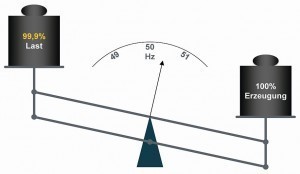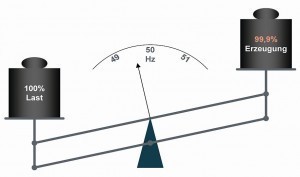Electrical energy is the only product that always has to be generated literally at the same moment it is consumed. Nevertheless, it is practically always available in full - whether it is used or not. How does that work? And can electroplating systems perhaps help to keep it that way?
2 The European interconnected grid
If the worst comes to the worst at one point in the grid, it is immediately noticeable everywhere in the grid due to the meticulous monitoring of the frequency. There is no need for a separate system for information transmission. Even a drop in frequency in the power grid signals a negative power balance: it indicates that the kinetic energy of the rotating masses is being "fed" at this point in time - the faster the frequency drops, the more it is fed. Conversely, if a large part of the load suddenly and unexpectedly fails, the frequency rises dangerously quickly. No such "jolt" in the load should ever cause the frequency to "go through the roof", because then power plants would disconnect from the grid in rows and the frequency would plummet. In both situations, a total blackout would occur in a matter of seconds.
However, it also follows from these considerations that if even just 1 ‰ (in words: one per thousand!) of the total power fed into the European interconnected grid suddenly fails unscheduled, the frequency drops from the upper (Fig. 4) to the lower crisis limit (Fig. 5) within just around 12 seconds. However, the largest power plant in the grid covers 1% rather than 1 ‰ of the power normally drawn from the European grid. This shows how quickly the balancing power plants have to react so that nothing happens if something does happen.
2.1 With momentum: seconds reserve
In absolute terms, the large number of rotating machines together generate a whole lot of mechanical energy. In fact, in the first moment after the failure of a large power plant unit (Fig. 7 to 9) or a large consumer, the missing power is replaced by the rotational energy of the immense number of machines remaining in operation or the surplus power is fed into them. Relatively speaking - in relation to the total power supplied at any given moment - the grid nevertheless contains very little kinetic energy. The need for action in the event of an outage is therefore correspondingly urgent.
Up to now, there has been just enough inertial mass in the grid to keep the frequency - i.e. the speed of the other generators - within limits and prevent it from "running away" when a large power plant or a very large load fails for the first moment before a controller can take effect. In grid operation, this is known as a second reserve or instantaneous reserve - and does not yet represent an intervention by any controller.
2.2 Primary control
![Abb. 9: Ausfall eines Kraftwerksblocks von 776 MW in der Türkei (29.9.2010) – nach 5 s auch in Spanien registriert (Amprion) [4] Abb. 9: Ausfall eines Kraftwerksblocks von 776 MW in der Türkei (29.9.2010) – nach 5 s auch in Spanien registriert (Amprion) [4]](/images/stories/Abo-2020-11/thumbnails/thumb_gt-2020-11-0200.jpg) Fig. 9: Outage of a 776 MW power plant unit in Turkey (29.9.2010) - also registered in Spain after 5 s (Amprion) [4]But this follows immediately. Nothing happens in the range from 49.99 Hz to 50.01 Hz. However, if this band is left, the primary control reserve "FCR" (frequency containment reserve) is activated. This means that all power plants in the grid that
Fig. 9: Outage of a 776 MW power plant unit in Turkey (29.9.2010) - also registered in Spain after 5 s (Amprion) [4]But this follows immediately. Nothing happens in the range from 49.99 Hz to 50.01 Hz. However, if this band is left, the primary control reserve "FCR" (frequency containment reserve) is activated. This means that all power plants in the grid that
- have prequalified for this
- are currently running
- but are not delivering their full output
- and are able to quickly change their output accordingly, i.e. typically gas-fired power plants and hydroelectric dam power plants or, of course, pumped storage power plants
automatically increase or reduce their output immediately to such an extent that the frequency stops falling or rising. The data on control power and control energy can be found at the Federal Network Agency [5] or in the original at ENTSO-E [6]. The contractually guaranteed primary balancing power should start after 5 seconds and must be available in full within 30 seconds. The instantaneous level must be set linearly between 100 % and -100 % depending on the frequency in the range from 49.8 Hz to 50.2 Hz. This is one of the conditions for prequalification. All UCTE members have committed to this, wherever and whenever the error may have occurred [7]: "In the event of frequency deviations, the primary control is called up jointly by technical units from the entire interconnected grid." All neighbors help; afterwards, the generated power should be equal to the consumption again, and the increase or decrease in frequency should have been stopped.
Flexible companies can draw negative balancing energy from the grid and compensate for power fluctuations
This process is not limited to generators. Consumers that can be switched on and off at will can also prequalify for the balancing power market - hence the negative range, which must also be covered. It does not necessarily mean the withdrawal of an ongoing feed-in, but can just as easily be implemented by switching on additional loads. The prerequisite in both cases is that an output of at least 1 MW (1 million watts) can be offered, which must account for at least 2% of the rated output of the corresponding facility. The power must be able to be supplied or drawn for at least 15 minutes - and this is the point at which the matter could become interesting for electroplating systems:
- It would be necessary to check how quickly such a facility could be taken off the grid and for how long, or by how much the power consumption could be reduced for a certain period of time. This difference in power consumption could then be offered on the market as positive control power.
- Galvanizing processes that have to run "at some point", i.e. are not tied to a specific period or time (of switching on), could be offered as negative balancing power in the event of a power surplus in the grid.
 Fig. 10: Primary balancing power provided in Germany and the prices paid for it in 2019Theeconomic viability of such offers must be examined in detail. In the first half of 2019, prices were still being tendered on a weekly basis. The available capacity hardly changed, remaining at exactly 600 MW for Germany for almost half a year (Fig. 10). It is immediately apparent that this is not enough to compensate for the failure of a 1300 MW unit, which is why the entire interconnected grid steps in. It was set up for this purpose. As mentioned, a total of around 3000 MW of primary control power is held in reserve for such cases.
Fig. 10: Primary balancing power provided in Germany and the prices paid for it in 2019Theeconomic viability of such offers must be examined in detail. In the first half of 2019, prices were still being tendered on a weekly basis. The available capacity hardly changed, remaining at exactly 600 MW for Germany for almost half a year (Fig. 10). It is immediately apparent that this is not enough to compensate for the failure of a 1300 MW unit, which is why the entire interconnected grid steps in. It was set up for this purpose. As mentioned, a total of around 3000 MW of primary control power is held in reserve for such cases.
The values have been available on a daily basis since July 1, 2019. Apparently, a more effective tendering procedure has been introduced here. Both the amount of capacity made available and the prices paid for it are now moving somewhat more sharply, but the average level has changed little (Fig. 10). Suppliers are only paid for the power, not for any energy supplied. Trading takes place on a suitable platform - in Germany the four transmission grid operators, corresponding to the four control areas - according to fixed rules.
Opening or closing the valves of a running gas, steam or water turbine a little further still takes a few seconds, even in the best-case scenario. Since the advances in accumulator technology brought about by lithium-ion cells, large accumulator systems are increasingly being used to provide such grid services [8]. The inverters installed in these systems, which work as rectifiers for charging and as inverters for feeding power back into the grid, can in principle be designed in such a way that they can switch from one mode to the other within milliseconds. In fact, this is exactly what the interconnected grid needs - today, in the context of the energy transition, to a much greater extent than in previous decades. This has to do with the increased use of electronics:
- As more and more wind turbines are able to feed in variable speed via a converter and the inertial mass of the generator and wind turbine therefore do not contribute to the second reserve (section 2.1), the inherent stability of the system is declining.
- The solar systems, which always feed into the grid via electronic inverters without any mechanics or inertia, also contribute to this effect and the system stability decreases even further.
- At the same time, the need for system stability increases, as cloud fields alternate with sunshine and winds alternate with lulls completely at random - at any rate regardless of the electricity demand.
However, electroplating systems are now electrochemical elements. Accumulators and galvanic rectifiers are comparable to those used to charge accumulators and can react as quickly as solar inverters.
It is noteworthy (Fig. 10) that only positive outputs and prices occur, i.e. obviously the same rates are always paid for both positive and negative primary control power. Meanwhile, however, a power plant running at 100% can only offer negative balancing power, as can an empty accumulator. Galvanics can do that too! Penalties for regulating in the wrong direction do not appear to be envisaged (in contrast to section 2.3.2). - to be continued -
Literature
[1] www.ucte.org (no longer available)
[2] R. Grebe: Of growing importance: grid stability in large interconnected grids, etz Elektrotechnik-Zeitschrift 6/1998, 35
[3] Friedhelm Noack: Introduction to electrical power engineering, Leipzig 2003
[4] Published in: ETG Mitgliederinformation 2/2011, 11
[5] www.smard.de
[6] https://transparency.entsoe.eu
[7] Prequalification procedure for reserve providers (FCR, aFRR, mFRR) in Germany - Draft for consultation - Status: 10.04.2018, www.regelleistung.net
[8] Petra Hannen: 11.5 megawatt storage facility in Varel put into operation, https://www.pv-magazine.de/2018/11/01/115-megawatt-speicher-in-varel-in-betrieb-genommen




![Abb. 6: Das UCTE-Netz: Alle an diesem Netz betriebenen Synchronmaschinen laufen tatsächlich synchron zueinander [1] Abb. 6: Das UCTE-Netz: Alle an diesem Netz betriebenen Synchronmaschinen laufen tatsächlich synchron zueinander [1]](/images/stories/Abo-2020-11/gt-2020-11-0197.jpg)
![Abb. 7: Ausfall eines großen Kraftwerksblocks von 900 MW in Spanien 1997 und die relativ geringen Folgen [2] Abb. 7: Ausfall eines großen Kraftwerksblocks von 900 MW in Spanien 1997 und die relativ geringen Folgen [2]](/images/stories/Abo-2020-11/thumbnails/thumb_gt-2020-11-0198.jpg)
![Abb. 8: Weiterer Ausfall eines großen Kraftwerksblocks – hier von 1300 MW (2002) – und die immer noch relativ geringen Folgen [3] Abb. 8: Weiterer Ausfall eines großen Kraftwerksblocks – hier von 1300 MW (2002) – und die immer noch relativ geringen Folgen [3]](/images/stories/Abo-2020-11/thumbnails/thumb_gt-2020-11-0199.jpg)
